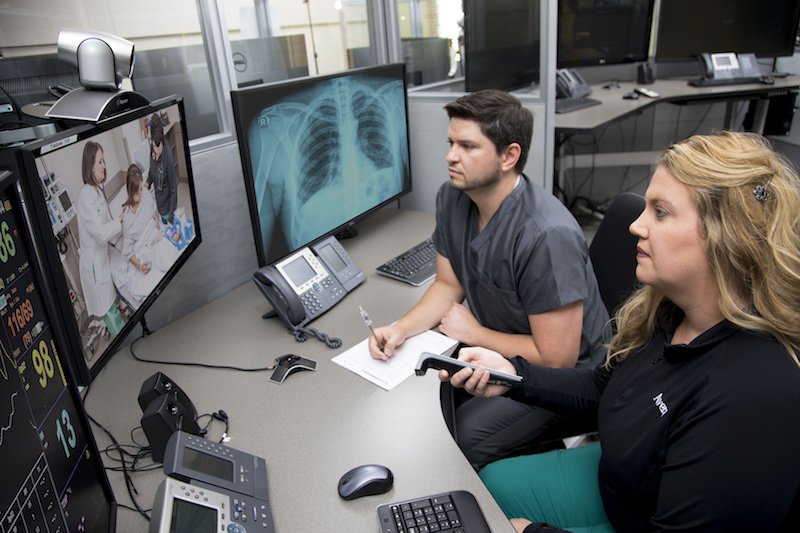Last Spring, construction began on a 16-story, 151-room tower at 139 East 56th Street in New York, which when completed in early 2020 will be Midtown Manhattan’s first purpose-built assisted living and memory care community.
The building—designed by SLCE and Champalimaud, and managed by Sunrise Senior Living—will offer “robust” telehealth services, says Mark Shaver, Senior Vice President-Strategy for Welltower, a leading healthcare REIT that with the real-estate firm Hines is the developer on this project.
“Our communities are proxies to [the patient’s] home, and the 56th Street facility will be the most technologically advanced, with full telemedicine systems so patients can receive care in their rooms,” says Shaver. “This is the future for us.”
Telehealth, which connects clinicians with patients in their homes through mobile devices, and telemedicine, which connects primary care or emergency department clinicians to medical specialists via technology to coordinate patient care, are bringing healthcare closer to where patients live.
At least half of all U.S. hospitals have telehealth or telemedicine programs. Studies have found that a sizable majority of patients doesn’t object to a telehealth option for interacting with caregivers. That’s good news for a medical profession that could face a shortfall of between 42,600 and 121,300 physicians by 2030, according to a recent study prepared for the Association of American Medical Colleges.
While there’s skepticism in some quarters about the extent that the telehealth movement is reducing the need for more medical centers or clinics, there’s evidence that it is helping to lower individuals’ healthcare expenses. For example, last year the University of California at Davis School of Medicine released a study that analyzed data on 19,426 patients over an 18-year period (July 1996 through December 2013). It found that telemedicine visits saved those patients the equivalent of nine years of travel time, five million miles, and $3 million in cost.
Telemedicine “is changing how services are accessed, and is providing access to a larger number of people,” observes James Crispino, Gensler’s Global Practice Leader-Healthcare. “The integration of telemedicine is largely in the development of a technology infrastructure that supports open access by all users, including patients and medical staff. Telemedicine should be seen as a portal to [provider] systems.”
A recent research letter posted by the Journal of American Medical Association (JAMA), based on an analysis of enrollee records from one large national health plan, concluded that while access to physicians via telehealth is still “uncommon” in the United States, consumer demand is increasing. Michael Barnett, M.D., an assistant professor at Harvard’s T.H. Chan School of Public Health and one of the letter’s authors, believes that telemedicine technology will be ubiquitous within the next decade, if current trends continue.
In light of such trends and conclusions, the medical profession and guidelines organizations are taking a closer look at how space for telehealth services should be designed and equipped for the best patient care and operational efficiency.
What can be ‘virtualized’?
This year, Avera Health celebrated the 25th anniversary of its launching of Avera eCARE, a business-to-business telehealth model that connects 400 healthcare sites across 17 states. During a typical month, Avera eCARE serves more than 18,000 patients and saves more than $4.7 million in healthcare costs, according to Deanna Larson, Avera eCARE’s CEO.
“What I always talk about is that when you’re considering a bricks and mortar facility, ask yourself what can be done virtually or with eCARE?” Larson tells BD+C.
Richard Molseed, Executive Vice President for Avera Health, notes that his system “is learning everyday about the eHealth environment.” Now, when Avera Health sets up clinics and EDs, “the first thing we place are the cameras, controls, and monitors.” Telehealth, he says, “has changed the way we practice.”
Avera eCARE has piloted a program that remotely monitors glucose levels of expectant mothers for gestational diabetes. It has expanded nursing services in schools in North and South Dakota by placing telehealth carts with specialized equipment like otoscopes and stethoscopes. It has also set up telehealth kiosks in Hy-Vee grocery stores, from which remote doctors can write prescriptions, and perform blood tests, and test patients for strep and flu.
In 2016, New York-Presbyterian launched NYP OnDemand, a suite of digital health services for such things as second opinions, consultations, follow-ups and urgent care, all available through an online portal.
“It’s meant to provide real-time video conferencing to reduce the need for ED visits, and to free up EDs for higher-need patients,” explains Shauna Coyne, the hospital’s Director of IT Innovation. There are now more than 50 telehealth programs within NYP OnDemand, and as of October 2018 the hospital had more than 60,000 online encounters between patients and remote physicians and other caregivers.
The hospital’s telehealth services include a telepsych initiative with Columbia University and Weill Cornell Medicine, which provides immediate care and limits a patient’s needing to stay overnight in a hospital. (The JAMA letter mentioned above points out that telemental health grew 56% annually to 57,095 visits in 2017 for the enrollees it tracked.)
New York-Presbyterian has set up telehealth kiosks in eight Walgreens pharmacies in New York City, and is piloting a program that allows professionals to monitor patients with Type 2 diabetes from their homes. The hospital’s mobile stroke units are equipped with CT scanners and video capability to connect with a remote neurologist who can monitor the patient’s symptoms and in-field treatment.
While telehealth isn’t leading to a reduction in ED physical space as yet, Coyne says it is making EDs more efficient by treating low-acuity patients at home through an urgent-care app or a drug-store kiosk. For patients who come to an ED, “we are reducing the time-to-provider and discharge times.”
As for the future of telehealth, Coyne expects more hospitals sending patients home with monitoring devices that allow healthcare professionals to track their recovery or status.

A 16-story tower in Midtown Manhattan for an assisted living and memory care community will include “robust” telehealth services. Image: Courtesy of Welltower.
Setting design guidelines
In October 2015, Mercy Virtual Care Center opened in Chesterfield, Mo. The four-story, 125,000-sf facility, which could draw from Mercy’s network of 43 hospitals in five states, almost immediately became the poster child for where telehealth could be headed in terms of integrating virtual services into a continuum of healthcare, and identifying more accessible and affordable care opportunities.
While Mercy Virtual’s size and magnitude—it includes an education center and think tank—haven’t been duplicated, more telehealth centers have been springing up. Coyne notes that New York-Presbyterian has a clinical care center on 60th Street and York Avenue in New York that’s completely virtual. And Avera eCARE’s 34,000-sf hub in Sioux Falls, S.D., provides nine (soon to be 11) virtual clinical services that include neurology, and planning for treatments such as radiology or oncology, says Larson. Avera eCARE also operates satellite telehealth centers in San Antonio, Michigan, and New Hampshire that, says Larson, are under pressure from increasing demand.
Also emerging is a consensus for what facilities need in order to offer telehealth services. Welltower’s Shaver, for one, says any telehealth center must start with strong and reliable WiFi connectivity.
In a piece she wrote for Medical Design + Construction magazine last February, Tama Duffy Day, FACHE, FASID, FIIDA, LEED BD+C, a Gensler Principal who runs the firm’s Health and Wellness practice in Washington D.C., explained that telemedicine’s game-changing trajectory hinges on how well it enables “genuine human connections” between practitioners and patients. Those interactions depend on such things as visual and aural privacy, workstations with movable screens, cameras that facilitate face-to-face contact, and lighting that minimizes shadows and glare.
Day also pointed out that larger-scale telemedicine buildings require increased electricity loads, redundant backup power, and automatic power transfer switching for continuous operations.
The Facilities Guidelines Institute’s 2018 Guidelines for Design and Construction of telemedicine facilities strikes a balance between the physical and virtual by establishing requirements for the size of telemedicine spaces, as well as for their privacy, acoustics, lighting, interior surfaces, site identification, and equipment storage. “Spaces for telemedicine communications should strive to maintain the level of safety, privacy, quality of care, and patient experience that would be expected for communication when it takes place in person,” wrote Ellen Taylor, AIA, EDAC, the Institute’s Vice President of Research, in an article about the new guidelines for Health Facilities Management magazine.
The Department of Veterans Affairs’ Virtual Integrated Multistate Patient Alliance Care Team (V-PACT) program currently serves 85 VA sites around the country that, for whatever reason, don’t have primary care providers or clinicians available. Matthew Rogers, the Clinical Operations Director of this program, says it will send in a virtual team that includes a physician, a pharmacist, and neurologists who provide care for a year remotely from V-PACT’s 15,000-sf hub in Boise, Idaho.
The VA’s telehealth program is organized in a hub-and-spoke arrangement, with 11 hubs combined with physical locations within VA campuses, and some staff who work at home. The VA’s healthcare system is divided into 18 Veteran Integrated Service Networks (VISNs), 10 of which currently are supported by telehealth hubs. Rogers says the goal is to support all VISNs with hubs.
To that end, the VA is in the process of developing a design guide for its telehealth facilities, starting with the Boise hub, which when completed with have at least 70 people on staff, with plans to double that number eventually.
The one thing that Rogers laments is that adoption of telehealth within the VA’s healthcare system has been slow, and that veterans in many parts of the country must still travel long distances to receive healthcare.
Insurance reimbursement is key to expansion
Telehealth is estimated as a $4.5 billion industry. Its growth is contingent, in part, on the extent that insurance covers care. Nearly all states require insurers to provide telehealth coverage. But Larson of Avera eCARE notes that reimbursement from third-party payers is still subject to negotiation some states, and that Medicare only pays for telehealth in rural geographies.
As consumer demand expands, though, insurers’ resistance is likely to soften, especially in states like Ohio, where in late November the health committee of its House of Representatives approved a bill that prohibits healthcare benefits from treating telemedicine services differently from in-person healthcare. That bill has bipartisan support and was likely to be passed by the full House, according to spokesman for Rep. Thomas Patton, the bill’s sponsor.
“Insurance payors are starting to recognize [telehealth] as a cost effective [way] to have earlier intervention,” says Larson.
Related Stories
Healthcare Facilities | Aug 18, 2023
Psychiatric hospital to feature biophilic elements, aim for net-zero energy
A new 521,000 sf, 350-bed behavioral health hospital in Lakewood, Wash., a Tacoma suburb, will serve forensic patients who enter care through the criminal court system, freeing other areas of campus to serve civil patients. The facility at Western State Hospital, to be designed by HOK, will promote a holistic approach to rehabilitation as part of the state’s vision for transforming behavioral health.
Healthcare Facilities | Aug 10, 2023
The present and future of crisis mental health design
BWBR principal Melanie Baumhover sat down with the firm’s behavioral and mental health designers to talk about how intentional design can play a role in combatting the crisis.
Market Data | Aug 1, 2023
Nonresidential construction spending increases slightly in June
National nonresidential construction spending increased 0.1% in June, according to an Associated Builders and Contractors analysis of data published today by the U.S. Census Bureau. Spending is up 18% over the past 12 months. On a seasonally adjusted annualized basis, nonresidential spending totaled $1.07 trillion in June.
Healthcare Facilities | Aug 1, 2023
Top 10 healthcare design projects for 2023
The HKS-designed Allegheny Health Network Wexford (Pa.) Hospital and Flad Architects' Sarasota Memorial Hospital - Venice (Fla.) highlight 10 projects to win 2023 Healthcare Design Awards from the American Institute of Architects Academy of Architecture for Health.
Designers | Jul 25, 2023
The latest 'five in focus' healthcare interior design trends
HMC Architects’ Five in Focus blog series explores the latest trends, ideas, and innovations shaping the future of healthcare design.
Market Data | Jul 24, 2023
Leading economists call for 2% increase in building construction spending in 2024
Following a 19.7% surge in spending for commercial, institutional, and industrial buildings in 2023, leading construction industry economists expect spending growth to come back to earth in 2024, according to the July 2023 AIA Consensus Construction Forecast Panel.
Healthcare Facilities | Jul 19, 2023
World’s first prefab operating room with fully automated disinfection technology opens in New York
The first prefabricated operating room in the world with fully automated disinfection technology opened recently at the University of Rochester Medicine Orthopedics Surgery Center in Henrietta, N.Y. The facility, developed in a former Sears store, features a system designed by Synergy Med, called Clean Cube, that had never been applied to an operating space before. The components of the Clean Cube operating room were custom premanufactured and then shipped to the site to be assembled.
Sponsored | | Jul 12, 2023
Keyless Security for Medical Offices
Keeping patient data secure is a serious concern for medical professionals. Traditional lock-and-key systems do very little to help manage this problem, and create additional issues of their own. “Fortunately, wireless access control — a keyless alternative — eliminates the need for traditional physical keys while providing a higher level of security and centralized control,” says Cliff Brady, Salto Director of Industry Sectors Engagement, North America. Let’s explore how that works.
Healthcare Facilities | Jul 10, 2023
The latest pediatric design solutions for our tiniest patients
Pediatric design leaders Julia Jude and Kristie Alexander share several of CannonDesign's latest pediatric projects.
Healthcare Facilities | Jun 27, 2023
Convenience ranks highly when patients seek healthcare
Healthcare consumers are just as likely to factor in convenience as they do cost when deciding where to seek care and from whom, according to a new survey of 4,037 American adults about their attitudes and preferences as patients. The survey, conducted from April 19-28 by JLL, in many ways confirms the obvious: that older generations seek preventive care more often than younger generations; that insurance coverage is a primary driver for choosing a provider or hospital; and that the quality of service affects the patient experience.

















